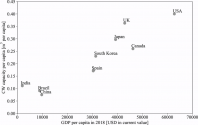What China really lacks is GMO crops/livestock, especially meant for human consumption. Yes I know that China is allowing a small amount of GMO crops to be planted this year, but it's way too small scale and slow, not to mention it's mainly going to be used for livestock and not for human consumption yet. China imports so much of it's food and with an increasing geopolitical tensions and worsening climate events, it's important for China to be fully self sufficient in food. There's issues with GMO crops yes, bad business practices, safely issues, too much dominance by western firms etc etc, but all are solvable.
The safely issue is mook, considering that GMO crops have been a thing for 3 decades at this point, have been subjected to tens of thousands of studies, billions of mouths without issues and much of the crops that China imports is GMO anyway. Bad business practices/monopolistic behavior aren't an issue with the right polices and control that the government has over the market. Dominance by western companies, again are not an issue with China's control over the market and China's own companies being pretty good enough to compete on their own merit.
Chinese scientist have had success with breeding and planting improved crops over the years, like salt-alkaline resistant crops, hybrid rice etc etc but that's via selective breeding and forced mutation, methods that were outdated decades ago. Modern genetic engineering methods are hundreds of times faster and cheaper, but they aren't being used nearly as much by China because of the heavy regulation surrounding GMO crops, there's no incentive if there's no market and chinese companies aren't being allowed to plant in chinese soil.
There's so much potential for GMO crops. Honestly companies like Monsanto are way too concerned with yield, profits and selling roundup. You could have crops that's extremely high in protein as much as meat, that's rich in certain vitamins, omega fatty acids, that need vastly less water/fertilizer, has a much longer shelf life. Or for non consumption purposes, like mangrove like plants that can actually reduce the salinity level of the surrounding soil, plants that absorb various toxic heavy metals, soils that improve soil health via increased biosequestration and nitrogen fixture. This kind of GMO crops don't make much profit and thus not much funding and attention, will probably need the government to step in if they are to be deployed in large scale.
And then there's livestock. A lot more risky, but the rewards are great. Just increased resistance to the common diseases that plague farmers would be a massive boost to the industry, to say nothing of increased growth and reproduction rates. Or more exotic options like an all female chicken line that reproduces asexually.
The safely issue is mook, considering that GMO crops have been a thing for 3 decades at this point, have been subjected to tens of thousands of studies, billions of mouths without issues and much of the crops that China imports is GMO anyway. Bad business practices/monopolistic behavior aren't an issue with the right polices and control that the government has over the market. Dominance by western companies, again are not an issue with China's control over the market and China's own companies being pretty good enough to compete on their own merit.
Chinese scientist have had success with breeding and planting improved crops over the years, like salt-alkaline resistant crops, hybrid rice etc etc but that's via selective breeding and forced mutation, methods that were outdated decades ago. Modern genetic engineering methods are hundreds of times faster and cheaper, but they aren't being used nearly as much by China because of the heavy regulation surrounding GMO crops, there's no incentive if there's no market and chinese companies aren't being allowed to plant in chinese soil.
There's so much potential for GMO crops. Honestly companies like Monsanto are way too concerned with yield, profits and selling roundup. You could have crops that's extremely high in protein as much as meat, that's rich in certain vitamins, omega fatty acids, that need vastly less water/fertilizer, has a much longer shelf life. Or for non consumption purposes, like mangrove like plants that can actually reduce the salinity level of the surrounding soil, plants that absorb various toxic heavy metals, soils that improve soil health via increased biosequestration and nitrogen fixture. This kind of GMO crops don't make much profit and thus not much funding and attention, will probably need the government to step in if they are to be deployed in large scale.
And then there's livestock. A lot more risky, but the rewards are great. Just increased resistance to the common diseases that plague farmers would be a massive boost to the industry, to say nothing of increased growth and reproduction rates. Or more exotic options like an all female chicken line that reproduces asexually.

